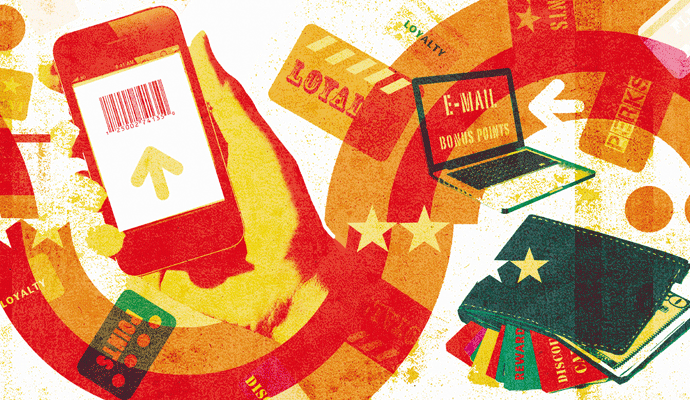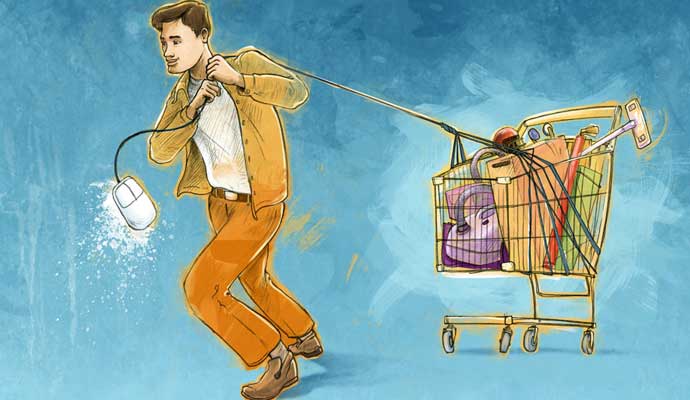Rewards Cards Test the Limits of Customer Loyalty
How I liberated myself from points and why it matters to your company.
One day recently I realized that my rewards card from the coffee shop chain I frequented was missing. At first, I was irritated — I had about $20 on the card along with some free beverage credits. After the initial upset, however, I soon felt strangely elated and liberated to unsubscribe from what was becoming an unwanted barrage of promotional emails.
The coffee shop rewards program had evolved over time from one that rewarded me for consistent behavior — a free beverage after buying a certain number — to what felt like an endless Pavlovian experiment in which I was expected to rush in at a specified day and time to try some new concoction in return for extra points. I had held on to get the occasional bonus for buying my morning coffee and bagel. Now, I wasn’t just card-free. I was free.
Shortly thereafter, I received a thick packet in the mail from an airline frequent-flyer program to which I belong. “Welcome,” its envelope proclaimed. Despite the glowing articulation of the benefits that awaited me, the real message was that I’d fallen down a rung by not flying enough miles within a given time frame. It felt like a “Dear John” letter.
The now-ubiquitous customer loyalty programs were originally conceived as ways to show appreciation to regular patrons and reinforce the bond between consumer and brand. So what’s gone wrong, and how did we get here? With the help of technology, loyalty programs have morphed into behavior-modification schemes that are transactional and ephemeral. Companies of all sorts, empowered by technology, are able to stimulate addictive behaviors in consumers, much in the way casino slot machines intermittently reward a pull of the handle. It’s called “brain hacking” and its practitioners are expert at triggering neurological pleasure and anxiety responses.
With the help of technology, customer-loyalty programs have morphed into behavior-modification schemes.
What these tech wizards can’t do, however, is hack the heart. The heart is where employees and customers develop an enduring bond with an organization and its brand, a bond once fostered by these programs. Yes, brand love is more rational and benefit-driven than interpersonal love, but it should be based on benefits to the customer, not to the company. If I’m left uneasy and guilt-ridden that I haven’t done enough to deserve the brand’s affection, as was the case with my frequent-flier program, something has gone deeply awry.
I helped establish one of the first loyalty programs by a national retailer in the 1980s at luxury leather goods purveyor, Mark Cross. Although my days in marketing are long passed, I’ve remained interested in these programs. How could I avoid them? Every credit card, hotel chain, review site, and even my wireless carrier is plying me with points. What has my attention now is the potential impact of all of this gamification on an organization’s customer service culture, and culture overall.
The Mark Cross initiative was designed to identify the firm’s best customers — knowledge at that time kept not in databases but in the closely guarded client books of individual salespeople — and ensure that those people knew their patronage was consistently recognized and rewarded. Customers were considered for the program if they met a minimum spending level. The program’s intent was to elevate service as well as spending.
Today, the goal is to get everyone into the pool and stoke their hopes of free travel and merchandise because doing so is lucrative. Bloomberg recently reported that airlines are making more money selling miles than seats. The programs are also an easy trigger for permission to market relentlessly, which risks backfiring and alienating customers with burdensome messages.
There is danger in having executives and frontline employees focused on getting customers to play the game rather than to engage more with the product or service. Attention shifts from building a human relationship to funneling people into the big data machine. Clerks and customers alike have ever-rising benchmarks to hit.
Great customer experiences are where brand commitment is born. I have found that as points offers have multiplied, overall service levels for non-elite customers have declined. Unfortunately for many consumers, the pursuit of points is akin to buying a lottery ticket. The odds of getting their dream prize get longer and longer. For example, the last time I tried to get a free ticket on the airline above, the only route available for what should be a seven-hour trip took me through four countries and lasted 24 hours. “Rewards” like that risk souring customers on the brand.
To be sure, some programs still work well. They are uncomplicated and undemanding. Examples include the hotel offerings that provide free Wi-Fi for members and the credit card programs whose points are redeemable for any flight or at a variety of merchants.
Fortunately, there is a new coffee shop in my neighborhood. Its loyalty program consists of a paper card that gets stamped. Nine stamps earn me a free cup of java. The employees concentrate on service and quality. You’ll find me there often — loyal and unburdened.






